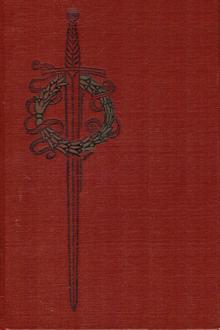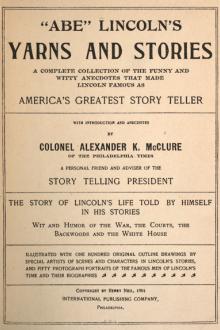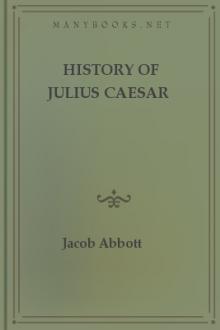Cyrus the Great by Jacob Abbott (thriller book recommendations .txt) 📕

- Author: Jacob Abbott
- Performer: -
Book online «Cyrus the Great by Jacob Abbott (thriller book recommendations .txt) 📕». Author Jacob Abbott
When this answer was reported to Crœsus, it is said that he was satisfied with the explanations, and admitted that the oracle was right, and that he himself had been unreasonable and wrong. However this may be, it is certain that, among mankind at large, since Crœsus's day, there has been a great disposition to overlook whatever of criminality there may have been in the falsehood and imposture of the oracle, through admiration of the adroitness and dexterity which its ministers evinced in saving themselves from exposure.
Chapter VIII. The Conquest of Babylon.B.C. 544-538
In his advance toward the dominions of Crœsus in Asia Minor, Cyrus had passed to the northward of the great and celebrated city of Babylon. Babylon was on the Euphrates, toward the southern part of Asia. It was the capital of a large and very fertile region, which extended on both sides of the Euphrates toward the Persian Gulf. The limits of the country, however, which was subject to Babylon, varied very much at different times, as they were extended or contracted by revolutions and wars.
Canals.
The River Euphrates was the great source of fertility for the whole region through which it flowed. The country watered by this river was very densely populated, and the inhabitants were industrious and peaceable, cultivating their land, and living quietly and happily on its fruits. The surface was intersected with canals, which the people had made for conveying the water of the river over the land for the purpose of irrigating it. Some of these canals were navigable. There was one great trunk which passed from the Euphrates to the Tigris, supplying many minor canals by the way, that was navigable for vessels of considerable burden.
Their mode of construction.
Primitive navigation.
The traffic of the country was, however, mainly conducted by means of boats of moderate size, the construction of which seemed to Herodotus very curious and remarkable. The city was enormously large, and required immense supplies of food, which were brought down in these boats from the agricultural country above. The boats were made in the following manner: first a frame was built, of the shape of the intended boat, broad and shallow, and with the stem and stern of the same form. This frame was made of willows, like a basket, and, when finished, was covered with a sheathing of skins. A layer of reeds was then spread over the bottom of the boat to protect the frame, and to distribute evenly the pressure of the cargo. The boat, thus finished, was laden with the produce of the country, and was then floated down the river to Babylon. In this navigation the boatmen were careful to protect the leather sheathing from injury by avoiding all contact with rocks, or even with the gravel of the shores. They kept their craft in the middle of the stream by means of two oars, or, rather, an oar and a paddle, which were worked, the first at the bows, and the second at the stern. The advance of the boat was in some measure accelerated by these boatmen, though their main function was to steer their vessel by keeping it out of eddies and away from projecting points of land, and directing its course to those parts of the stream where the current was swiftest, and where it would consequently be borne forward most rapidly to its destination.
These boats were generally of very considerable size, and they carried, in addition to their cargo and crew, one or more beasts of burden—generally asses or mules. These animals were allowed the pleasure, if any pleasure it was to them, of sailing thus idly down the stream, for the sake of having them at hand at the end of the voyage, to carry back again, up the country, the skins, which constituted the most valuable portion of the craft they sailed in. It was found that these skins, if carefully preserved, could be easily transported up the river, and would answer the purpose of a second voyage. Accordingly, when the boats arrived at Babylon, the cargo was sold, the boats were broken up, the skins were folded into packs, and in this form the mules carried them up the river again, the boatmen driving the mules as they walked by their side.
Parks, gardens, palaces, etc.
Babylon was a city of immense extent and magnitude. In fact, the accounts given of the space which it covered have often been considered incredible. These accounts make the space which was included within the walls four or five times as large as London. A great deal of this space was, however, occupied by parks and gardens connected with the royal palaces, and by open squares. Then, besides, the houses occupied by the common people in the ancient cities were of fewer stories in height, and consequently more extended on the ground, than those built in modern times. In fact, it is probable that, in many instances, they were mere ranges of huts and hovels, as is the case, indeed, to a considerable extent, in Oriental cities, at the present day, so that it is not at all impossible that even so large an area as four or five times the size of London may have been included within the fortifications of the city.
Marvelous accounts.
In respect to the walls of the city, very extraordinary and apparently contradictory accounts are given by the various ancient authors who described them. Some make them seventy-five and others two or three hundred feet high. There have been many discussions in respect to the comparative credibility of these several statements, and some ingenious attempts have been made to reconcile them. It is not, however, at all surprising that there should be such a diversity in the dimensions given, for the walling of an ancient city was seldom of the same height in all places. The structure necessarily varied according to the nature of the ground, being high wherever the ground without was such as to give the enemy an advantage in an attack, and lower in other situations, where the conformation of the surface was such as to afford, of itself, a partial protection. It is not, perhaps, impossible that, at some particular points—as, for example, across glens and ravines, or along steep declivities—the walls of Babylon may have been raised even to the very extraordinary height which Herodotus ascribes to them.
The walls were made of bricks, and the bricks were formed of clay and earth, which was dug from a trench made outside of the lines. This trench served the purpose of a ditch, to strengthen the fortification when the wall was completed. The water from the river, and from streams flowing toward the river, was admitted to these ditches on every side, and kept them always full.
The sides of these ditches were lined with bricks too, which were made, like those of the walls, from the earth obtained from the excavations. They used for all this masonry a cement made from a species of bitumen, which was found in great quantities floating down one of the rivers which flowed into the Euphrates, in the neighborhood of Babylon.
The River Euphrates itself flowed through the city. There was a breast-work or low wall along the banks of it on either side, with openings at the terminations of the streets leading to the water, and flights of steps to go down. These openings were secured by gates of brass, which, when closed, would prevent an enemy from gaining access to the city from the river. The great streets, which terminated thus at the river on one side, extended to the walls of the city on the other, and they were crossed by other streets at right angles to them. In the outer walls of the city, at the extremities of all these streets, were massive gates of brass, with hinges and frames of the same metal. There were a hundred of these gates in all. They were guarded by watch-towers on the walls above. The watch-towers were built on both the inner and outer faces of the wall, and the wall itself was so broad that there was room between these watch-towers for a chariot and four to drive and turn.
Temple of Belus.
The river, of course, divided the city into two parts. The king's palace was in the center of one of these divisions, within a vast circular inclosure, which contained the palace buildings, together with the spacious courts, and parks, and gardens pertaining to them. In the center of the other division was a corresponding inclosure, which contained the great temple of Belus. Here there was a very lofty tower, divided into eight separate towers, one above another, with a winding staircase to ascend to the summit. In the upper story was a sort of chapel, with a couch, and a table, and other furniture for use in the sacred ceremonies, all of gold. Above this, on the highest platform of all, was a grand observatory, where the Babylonian astrologers made their celestial observations.
Sculptures.
There was a bridge across the river, connecting one section of the city with the other, and it is said that there was a subterranean passage under the river also, which was used as a private communication between two public edifices—palaces or citadels—which were situated near the extremities of the bridge. All these constructions were of the most grand and imposing character. In addition to the architectural magnificence of the buildings, the gates and walls were embellished with a great variety of sculptures: images of animals, of every form and in every attitude; and men, single and in groups, models of great sovereigns, and representations of hunting scenes, battle scenes, and great events in the Babylonian history.
Construction of the gardens.
The most remarkable, however, of all the wonders of Babylon—though perhaps not built till after Cyrus's time—were what were called the hanging gardens. Although called the hanging gardens, they were not suspended in any manner, as the name might denote, but were supported upon arches and walls. The arches and walls sustained a succession of terraces, rising one above another, with broad flights of steps for ascending to them, and on these terraces the gardens were made. The upper terrace, or platform, was several hundred feet from the ground; so high, that it was necessary to build arches upon arches within, in order to attain the requisite elevation. The lateral thrust of these arches was sustained by a wall twenty-five feet in thickness, which surrounded the garden on all sides, and rose as high as the lowermost tier of arches, upon which would, of course, be concentrated the pressure and weight of all the pile. The whole structure thus formed a sort of artificial hill, square in form, and rising, in a succession of terraces, to a broad and level area upon the top. The extent of this grand square upon the summit was four hundred feet upon each side.
Engine for raising water.
The surface which served as the foundation for the gardens that adorned these successive terraces and the area above was formed in the following manner: Over the masonry of the arches there was laid a pavement of broad flat stones, sixteen feet long and four feet wide. Over these there was placed a stratum of reeds, laid in bitumen, and above them another flooring of bricks, cemented closely together, so as to be impervious to water. To make the security complete in this respect, the upper surface of this brick flooring was covered with





Comments (0)